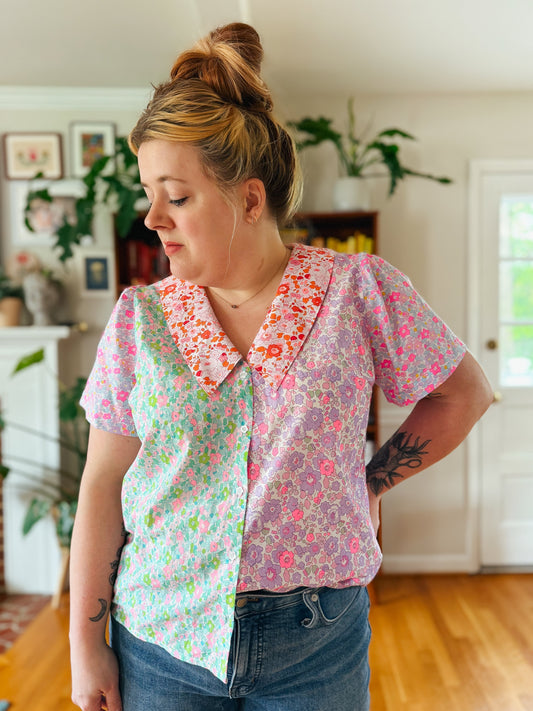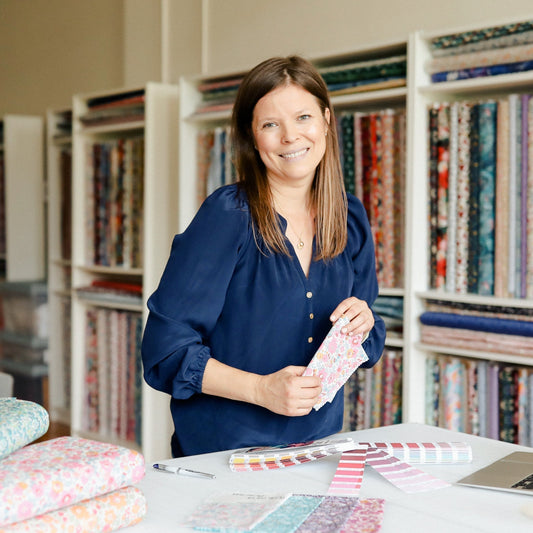#MemadeMay is here! We're so excited to kick off a month of celebrating our sewing community's creativity and self made wardrobes! This month is the perfect time to start sewing your own wardrobe and we're here to help. Newbie garment sewer Erin and experienced garment sewer Leslie sat down together to chat about garment sewing essentials and Leslie's tips and tricks to begin your garment sewing journey!
In case you haven't heard, DuckaDilly is hosting giveaways this May to help you sew your dream Liberty wardrobe! Post a photo of your makes, tag #memadeduckadilly, and mention @duckadillyfabrics for a chance to win a $250 DuckaDilly gift card! See our Instagram for more information!
What supplies do I need to start?
When you want to begin sewing your own clothes, it can feel really daunting. Like there must be tons of tools you need to do it "right". Luckily, the supplies list is really quite short, and probably a lot of it is already to hand.
- Sewing machine - this does not need to be a fancy new machine! Leslie has been sewing with the same machine since she first started sewing at 13!
- Iron/ironing board
- Sharp machine needle, such as Schmetz Microtex 70/10
- Handsewing needle, such as Clover Black Gold Needles
- All-purpose polyester thread, such as Gütermann or Mettler
- Fine pins, such as Clover Patchwork Pins
- Soft tape measure for measuring yourself
- Fabric scissors
- Seam ripper
- Chalk pencil/tailor's pencil
Additional pattern specific tools & notions
- Elastic
- Buttons
- Bias tape
- Zipper foot & zipper

Let's talk basics!
Whether you are a quilter who is ready to make their first shirt or an eager beginner who has never threaded a needle, the wider sewing community, including lovely companies like Sew Liberated & Closet Core Patterns and countless sewists like Evelyn Wood on platforms like Youtube and Instagram are ready to share their knowledge and expertise. There are tutorials on all the basics: how to thread your bobbin, care for your machine, sew a straight line, etc. If you would like structure and guidance to your journey, Sew Liberated and Closet Core Patterns both have paid courses about how to sew your own wardrobe. These are project based courses and they start with the basics!
When you are ready to take on new techniques, you can find tutorials on just about everything! We suggest getting a feel for your machine and trying out new techniques on scrap fabrics before you cut into your special fabrics.
If you're getting ready to sew your first garment, we recommend getting comfortable with the following techniques before breaking out your first project:
- Threading your sewing machine (including the bobbin)
- Sewing a straight seam while following a marked line on the fabric
- Sewing a straight seam while using a measurement mark on your sewing machine
- How to start and end a seam with backstitching
When I was first learning to sew and getting used to the flow of a sewing machine, my teacher initially gave me pages with simple lines drawn on them, and I practiced my stitching by following those lines. The first couple were straight, but then they got a little wavy, until the final ones were full spirals and right angles! It's a great way to get more comfortable with the needle's movement before thread and fabric even get into the mix.
Pattern Selection
Now that you are familiar with your machine and have a little practice under your belt, you are ready to start your first garment! There are so many patterns out there, it can be hard to know where to begin. We've put together a list of some of our favorite patterns that we find approachable for beginners. You'll find that all of these patterns are labeled as beginner or confident beginner in the pattern's description. These patterns don't include tricky embellishments, but they produce well constructed garments and are appreciated by all levels of stitchers! This is by no means a comprehensive list of beginner-friendly patterns, and we encourage you to explore what's out there.
While you're browsing patterns, here's some things to consider:
- Look for: straight seams, clear instructions on finishing, playful but simple details, easier closures
- Avoid: heavily curved seams (such as a strong princess-seamed bodice), easing (like set-in sleeves), complicated or fiddly details and closures (fitted shirts with collar, collar stand, button plackets, etc)
- If you are curious about a pattern, you can check out sewing.patternreview.com to see other sewists' finished garments (and photos on non-models) and honest feedback before starting any project.
- Look for something you're excited about wearing! Most of the fun of making your own clothes is adding new favorite things to your wardrobe.
A few patterns to consider:
- Estuary Skirt from Sew Liberated - Don't be afraid of the buttons because this can be sewn as a buttonhole-free placket & there is a step-by-step sew along!
- Wilder Gown or Top from Friday Pattern Co. *Leslie has made this one!*
- Peplum top from Peppermint - This pattern is pay what you want! The grading of the larger sizes can be a bit off. We recommend looking at the finished garment measurements to help you decide which size to make.
- Goji Shorts + Skirt Pattern from Deer and Doe - A two-in-one pattern!
- Ogden Cami from True Bias- This pattern is very "hackable". True Bias has an entire section of their site dedicated to pattern hacks!

Let's sew!
You know your machine, you have selected a pattern, and you have acquired the recommended fabric. You're ready to sew! As you start your garment sewing journey, there are some habits that will help your success and your enjoyment!
- Read the whole pattern before you start. You want to be able to walk through the steps in your head. If there is any point that doesn't make sense, focus on that bit until it does. It's always better to visualize/conceptualize the steps before cutting/trimming/clipping away fabric you can't put back. When you can visualize how parts will interact, it can also help you more intuitively know when to do certain things like ironing, or finishing interior seams.
- Don't base the size you choose only from the measurement tables. Check the finished garment measurements if available and measure the pattern pieces to check if the garment will fit the way you expect it to.
- Take your measurements while wearing the undergarments you'll want to wear with the piece.
- Keep a log of the patterns you sew, the adjustments you made, things you liked or didn't like, etc. If you have a physical copy of the pattern, write it on there. A note to future-you!
- Be kind to yourself and be proud of your work at each stage of the process. Learning a new skill takes time and practice. There's beauty in every stage of the journey!
Stay tuned as we dive further into the garment sewing world! We'll be here all month long exploring techniques, interviewing some of our favorite makers, and chatting about our love of sewing.
Don't forget to share your work! #Memademay is all about sharing your journey with the sewing community.
We can't wait to see all the beautiful things you make!





